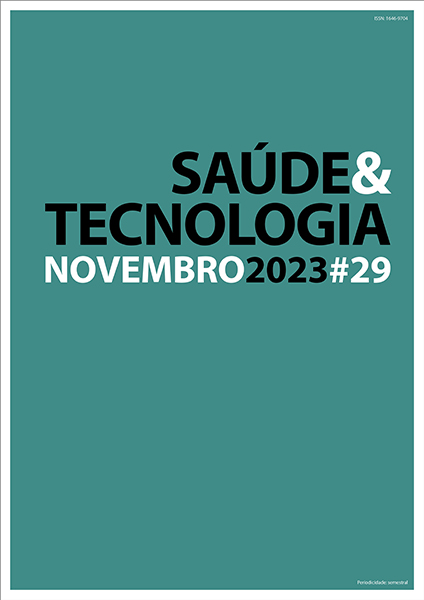Relationship between school hours and myopia in Portuguese young adults
DOI:
https://doi.org/10.25758/set.788Keywords:
Myopia, High myopia, Age of onset, Time outdoors, School hours, Extracurricular activities, Questionnaire, Young portuguese adultsAbstract
Introduction – Myopia is a common condition with onset at school age. It is a multifactorial refractive anomaly associated with excessive axial length growth. Environmental risk factors are related to near work, number of years of schooling, and reduced outdoor activity. The age of onset of myopia is a risk factor for faster progression and risk of high myopia (≤-5.00
diopters, D). Aims – To study the relationship between school hours, extracurricular activities, and time outdoors and the age of myopia onset in young Portuguese adults. Methods – A descriptive cross-sectional study was developed. Refractive data was collected from seven optical stores in Portugal. The study included individuals between 25 years of age and 40 years of age. Through a questionnaire, data on risk factors (near work, time outdoors, tutorial classes, and years of study) were collected to analyze their influence on the age of onset of myopia and spherical equivalent
(SE). Multiple linear regression models were applied to evaluate factors associated with the age of onset of myopia and SE. Results – Myopic adults (n=54) with SE between -0.50 and -18.50 D were included. The average age was 32.63±4.37 years and 51.85% were female. The mean SE was -3.19±2.96 and the mean age of onset of myopia was 14.44±7.39 years. Adults with more negative
SE had an earlier age of onset (B=2.36; p<0.001). Adults with more years of education (B=-0.20; p=0.030) and earlier age of onset had more negative SE (B=0.17; p<0.001). Conclusions – This study showed that the earlier the age at which myopia appears, the more negative the SE value was. Furthermore, the more negative SE was influenced by a greater number of years of study.
Downloads
References
Bremond-Gignac D. Myopie de l’enfant [Myopia in children]. Med Sci (Paris). 2020;36(8-9):763-8. French
Díaz Llopis M, Cisneros Lanuza A. Myopia, the challenge of ophthalmology and its worldwide “explosive epidemic”. Arch Soc Esp Oftalmol. 2018;93(8):365-7.
Vagge A, Desideri LF, Nucci P, Serafino M, Giannaccare G, Traverso CE. Prevention of progression in myopia: a systematic review. Diseases. 2018;6(4):92.
Baird PN, Saw SM, Lanca C, Guggenheim JA, Smith III EL, Zhou X, et al. Myopia. Nat Rev Dis Primers. 2020;6(1):99.
Jonas JB, Ang M, Cho P, Guggenheim JA, He MG, Jong M, et al. IMI prevention of myopia and its progression. Invest Ophthalmol Vis Sci. 2021;62(5):6.
Wu PC, Huang HM, Yu HJ, Fang PC, Chen CT. Epidemiology of myopia. Asia Pac J Ophthalmol. 2016;5(6):386-93.
Nickla DL, Thai P, Trahan RZ, Totonelly K. Myopic defocus in the evening is more effective at inhibiting eye growth than defocus in the morning: effects on rhythms in axial length and choroid thickness in chicks. Exp Eye Res. 2017;154:104-15.
Sarfare S, Yang J, Nickla DL. The effects of brief high intensity light on ocular growth in chicks developing myopia vary with time of day. Exp Eye Res. 2020;195:108039.
Nickla DL, Jordan K, Yang J, Totonelly K. Brief hyperopic defocus or form deprivation have varying effects on eye growth and ocular rhythms depending on the time-of-day of exposure. Exp Eye Res. 2017;161:132-42.
Rodrigues A, Ramos F, Rodrigues IP, Gregório MC, Félix P, Perdigão R, et al. Organização escolar: o tempo [homepage]. Lisboa: Conselho Nacional de Educação; 2017. Available from: https://www.cnedu.pt/pt/publicacoes/estudos/1207-organizacao-escolar-o-tempo
Lee SS, Mackey DA. Prevalence and risk factors of myopia in young adults: review of findings from the Raine study. Front Public Health. 2022;10:861044.
Pärssinen O, Kauppinen M. Risk factors for high myopia: a 22‐year follow‐up study from childhood to adulthood. Acta Ophthalmol. 2019;97(5):510-8.
Chua SY, Sabanayagam C, Cheung YB, Chia A, Valenzuela RK, Tan D, et al. Age of onset of myopia predicts risk of high myopia in later childhood in myopic Singapore children. Ophthalmic Physiol Opt. 2016;36(4):388-94.
Lanca C, Szeps A, Iribarren R. Role of tutorial classes and full day schooling on self-reported age of myopia onset: findings in a sample of Argentinian adults. J AAPOS. 2022;26(6):314e1-e6.
Ding X, Morgan IG, Hu Y, Yuan Z, He M. Exposure to the life of a school child rather than age determines myopic shifts in refraction in school children. Investig Ophthalmol Vis Sci. 2022;63(3):15.
Mountjoy E, Davies NM, Plotnikov D, Smith GD, Rodríguez S, Williams CE, et al. Education and myopia: assessing the direction of causality by mendelian randomisation. BMJ. 2018;361:k2022.
Mirshahi A, Ponto KA, Hoehn R, Zwiener I, Zeller T, Lackner K, et al. Myopia and level of education: results from the Gutenberg Health Study. Ophthalmology. 2014;121(10):2047-52.
Morgan IG, Rose KA. Myopia and international educational performance. Ophthalmic Physiol Opt. 2013;33(3):329-38.
Downloads
Published
Issue
Section
License
Copyright (c) 2023 Saúde & Tecnologia

This work is licensed under a Creative Commons Attribution-NonCommercial-NoDerivatives 4.0 International License.
The journal Saúde & Tecnologia offers immediate free access to its content, following the principle that making scientific knowledge available to the public free of charge provides greater worldwide democratization of knowledge.
The journal Saúde & Tecnologia does not charge authors any submission or article processing charges (APC).
All content is licensed under a Creative Commons CC-BY-NC-ND license. Authors have the right to: reproduce their work in physical or digital form for personal, professional, or teaching use, but not for commercial use (including the sale of the right to access the article); deposit on their website, that of their institution or in a repository an exact copy in electronic format of the article published by Saúde & Tecnologia, provided that reference is made to its publication in Saúde & Tecnologia and its content (including symbols identifying the journal) is not altered; publish in a book of which they are authors or editors the total or partial content of the manuscript, provided that reference is made to its publication in Saúde & Tecnologia.







